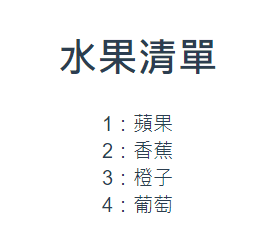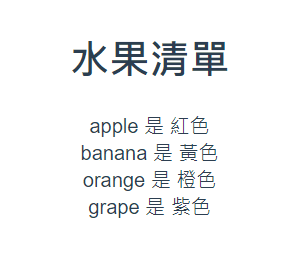前言
在 Vue.js 中,v-for 指令用於在模板中渲染列表。它可以輕鬆地根據數組或對象生成多個元素,並支持渲染各種類型的資料結構。
基本語法
v-for 的基本語法如下:
1
| v-for="(item, index) in items"
|
item:當前迭代的元素。index:當前元素的索引(可選)。items:要迭代的數組或對象。
搭配 key
使用 v-for 時,必須為每個項目提供唯一的 key,以便 Vue 更高效地進行 DOM 更新。key 必須是唯一且不重複的值。基本語法如下:
1
| v-for="(item, index) in items" :key="item.id"
|
key 的重要性
- 提升性能:使用
key 可以幫助 Vue 更智能地重用和重新排序元素,從而減少不必要的 DOM 操作。
- 保持狀態:當列表項目包含狀態(如輸入框內容)時,
key 可確保狀態不會丟失。
- 減少重渲染:在列表項目添加、刪除或重新排序時,
key 使更新更精確。
範例
以下是 2 個簡單的範例,資料源分別是 陣列 與 物件 的格式,展示如何使用 v-for 渲染一個水果清單。
陣列用法
1
2
3
4
5
6
7
8
9
10
| <template>
<div>
<h1>水果清單</h1>
<ul>
<li v-for="(item, index) in fruits" :key="index">
{{ index + 1 }}:{{ item }}
</li>
</ul>
</div>
</template>
|
1
2
3
4
5
6
7
8
9
| <script>
export default {
data() {
return {
fruits: ['蘋果', '香蕉', '橙子', '葡萄']
};
}
};
</script>
|
1
2
3
4
5
6
7
8
9
10
11
12
13
| <script>
import { ref } from 'vue';
export default {
setup() {
const fruits = ref(['蘋果', '香蕉', '橙子', '葡萄']);
return {
fruits,
};
}
};
</script>
|
1
2
3
4
5
6
7
| <script setup>
import { ref } from 'vue';
const fruits = ref(['蘋果', '香蕉', '橙子', '葡萄']);
</script>
|

物件用法
1
2
3
4
5
6
7
8
9
10
| <template>
<div>
<h1>水果清單</h1>
<ul>
<li v-for="(color, fruit) in fruits" :key="fruit">
{{ fruit }} 是 {{ color }}
</li>
</ul>
</div>
</template>
|
1
2
3
4
5
6
7
8
9
10
11
12
13
14
| <script>
export default {
data() {
return {
fruits: {
apple: '紅色',
banana: '黃色',
orange: '橙色',
grape: '紫色'
}
};
}
};
</script>
|
1
2
3
4
5
6
7
8
9
10
11
12
13
14
15
16
17
18
| <script>
import { reactive } from 'vue';
export default {
setup() {
const fruits = reactive({
apple: '紅色',
banana: '黃色',
orange: '橙色',
grape: '紫色'
});
return {
fruits,
};
}
};
</script>
|
1
2
3
4
5
6
7
8
9
10
| <script setup>
import { reactive } from 'vue';
const fruits = reactive({
apple: '紅色',
banana: '黃色',
orange: '橙色',
grape: '紫色'
});
</script>
|

總結
v-for 是 Vue.js 中非常強大的指令,用於動態生成列表。無論是數組還是對象,它都能輕鬆處理,並且能夠有效地跟蹤元素的變化。希望這篇筆記能幫助你更好地理解和使用 v-for!

